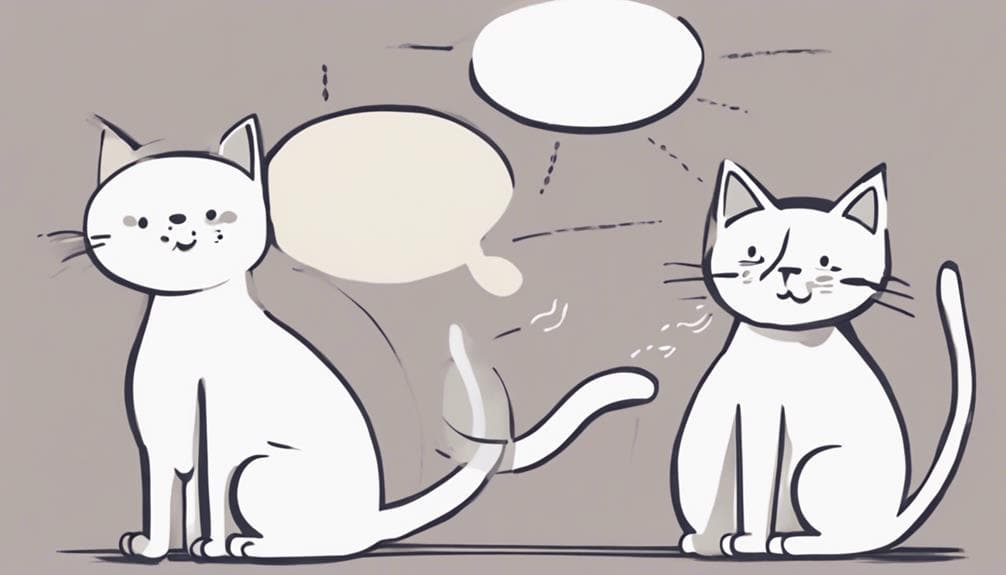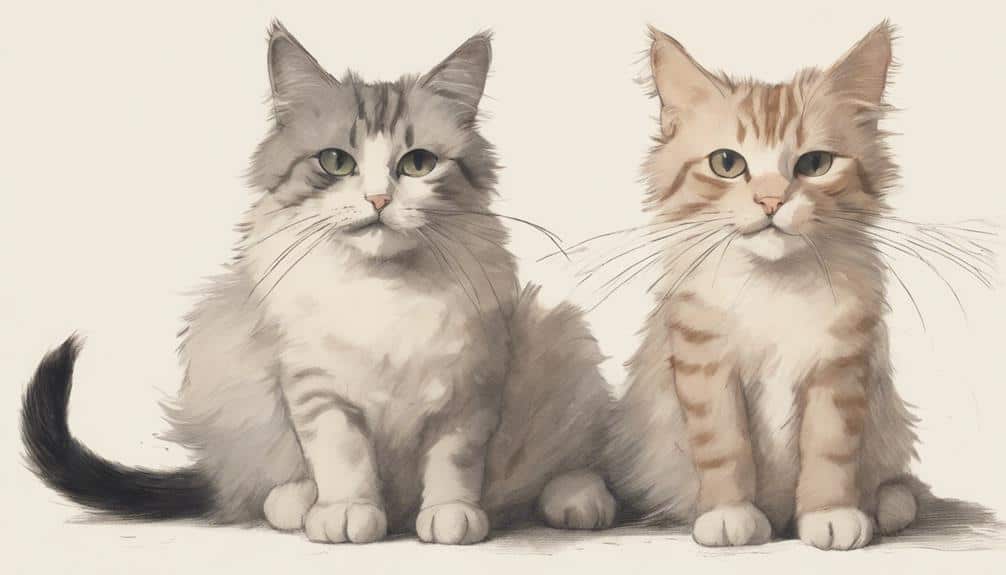You can determine whether your cats are playing or fighting by paying attention to their body language, vocalizations, and interaction intensity. If they display smooth movements, cheerful chirps, and moderate intensity with pauses, they're likely playing. On the other hand, tense postures, aggressive noises, and high-intensity continuous aggression suggest fighting. By recognizing these signs, you can step in if necessary and guarantee your cats' safety. Want to know more about deciphering your cats' behavior and safeguarding their well-being?
Key Takeaways
• Smooth body movements and cheerful vocalizations indicate playing, while tense postures and aggressive noises suggest fighting.
• Ears forward or upright signify friendly play, while backward or flattened ears indicate aggression.
• Moderate interaction intensity with pauses is typical of play, while high intensity with continuous aggression suggests fighting.
• Gentle swatting, chasing, and mock biting are characteristic of play, while intense physical altercations signify fighting.
• Recognizing signs of play and fighting helps maintain harmony in a multi-cat household and ensures the cats' safety.
Body Language Cues
When observing your cat's behavior, pay attention to their body language, as it's often the most reliable indicator of whether they're playing or fighting. You can distinguish between playful and aggressive behavior by examining your cat's posture and movements. If your cat is relaxed, with smooth movements, it's likely they're playing. On the other hand, tense and rigid postures are characteristic of fighting.
Notice how your cat carries themselves. Are they puffing out their fur, trying to appear larger? This could be a sign of aggression. Conversely, if they're rolling around on the ground, they're probably just having fun. Take a closer look at their ears, too. Forward or upright ears are indicative of friendly play, while backward or flattened ears suggest aggression.
Vocalization Patterns

You can identify whether your cats are playing or fighting by paying attention to the vocalization patterns they exhibit during interactions. When one cat initiates play, it often lets out cheerful noises like chirping or trilling, signaling to the other cat that it's time to have fun.
On the other hand, cats fighting often produce aggressive sounds like hissing, growling, or yowling, indicating a more serious confrontation.
If you notice meowing during interactions, it's usually a sign of playful behavior, not a fight. Clear vocal signals can help differentiate between cats playing and cats fighting. For instance, a loud noise can indicate aggression, while softer, more high-pitched sounds suggest play fighting.
Interaction Intensity

Both playful and aggressive interactions between cats exhibit distinct characteristics, but a closer examination of interaction intensity can often be the deciding factor in determining whether your cats are playing or fighting.
As a cat owner, recognizing the signs is crucial to maintaining a harmonious multi-cat household.
When observing your cats' behavior, look for the following signs to determine the intensity of their interaction:
- Moderate intensity with occasional pauses indicates a play session, whereas high intensity with continuous aggression suggests fighting cats.
- Gentle swatting, chasing, and mock biting are characteristic of playful interactions, whereas intense physical altercations signify fighting.
- Breaks and changes in activity during play sessions are common, whereas fights escalate quickly without pauses or breaks.
- Relaxed body language and soft vocalizations are typical of playful cats, whereas tense bodies and aggressive vocalizations indicate fighting.
Frequently Asked Questions
How Can I Tell if My Cat Is Just Playing or Actually Fighting?
You're probably wondering if your cat is just having the time of their life or actually duking it out with their feline friend. Let's face it, it's like trying to decipher a secret language!
To crack the code, pay attention to the sounds, body language, and tail movements. Are you hearing playful chirps or menacing growls? Are their ears perked up or flattened? Are they taking turns or going at it nonstop?
Why Are My 3 Cats Fighting?
Identifying the root cause of why your 3 cats are fighting is crucial. Are they competing for resources, defending their territory, or reacting to changes in their environment? Perhaps there's an underlying health issue or a new cat that's disrupting their dynamics.
Take note of any sudden behavioral changes, like increased aggression or avoidance, as these can indicate underlying issues.
Is My Cat Playful or Aggressive?
You're wondering if your cat is playful or aggressive. Observe their behavior: are they relaxed and smooth in their movements, or do they display confrontational body language?
Do they chase and wrestle, or bare their teeth and show piloerection? Recognizing these signs will help you determine whether your cat is playful or aggressive.
How to Tell if Cats Are Friends or Enemies?
As you observe the whiskered duo, you wonder: are they sworn enemies or the best of feline friends? To decipher their relationship, watch for subtle cues. Do they groom each other, or display relaxed body language?
Do they take breaks from play, only to resume with renewed energy? If so, it's likely they're the best of pals. Conversely, if hisses and growls dominate their interactions, it's a different story altogether.



